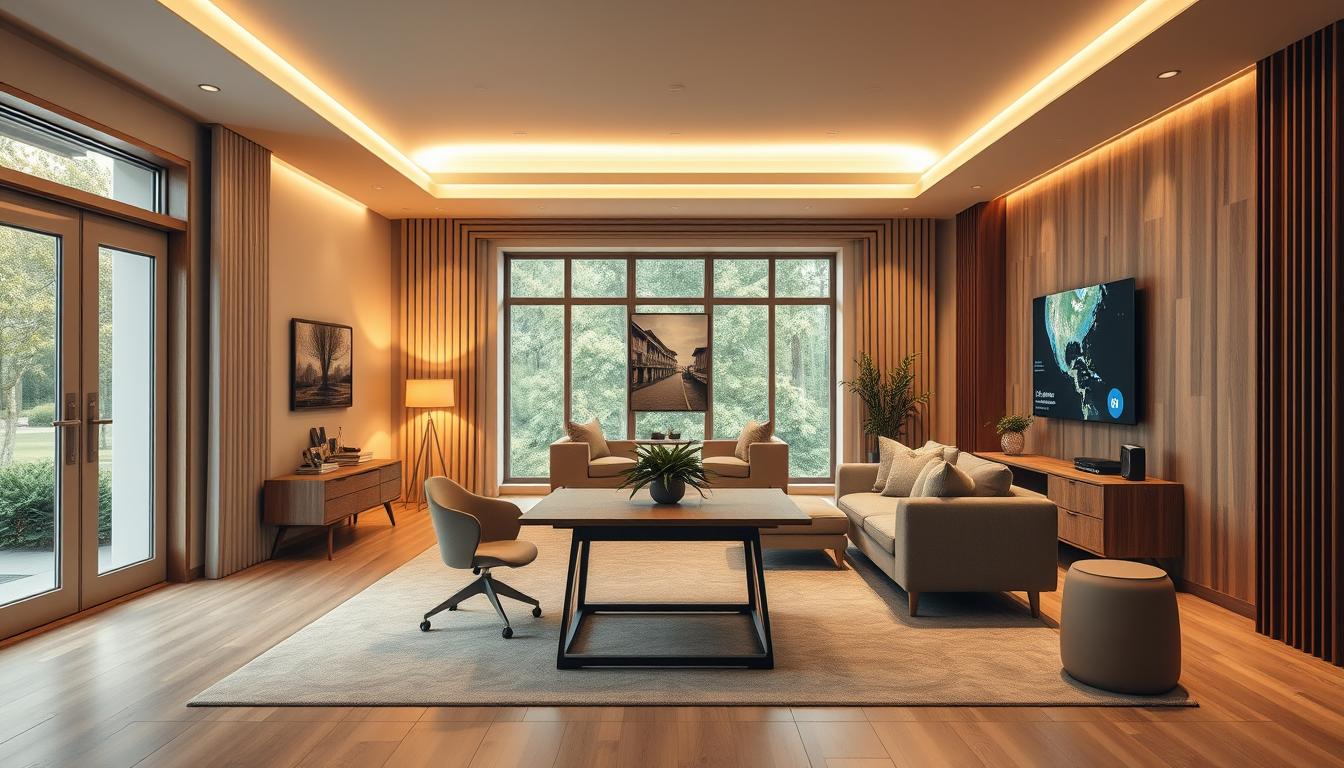Welcome to my guide on creating a smart home for disabilities. Here, I’ll share my knowledge on assistive technology and adaptive home solutions. My aim is to help you make a living space that’s comfortable, easy to use, and accessible. We’ll use smart home technology to achieve this.
A smart home for disabilities can really improve your daily life. It gives you the freedom and safety you need. With smart home tech, you can create a space that fits your needs and abilities. This includes using assistive technology and adaptive home solutions.
In this guide, I’ll show you how to build a smart home for disabilities. We’ll look at the benefits of smart home tech and the key devices that can change your life. These include assistive technology for disabled individuals and adaptive home solutions.
Understanding Smart Homes and Accessibility
Exploring smart homes is exciting, especially how they help people with disabilities. A smart home uses advanced tech to make living easier and more comfortable. It lets people with disabilities live more independently and control their space better.
Smart homes are great because they can be designed for everyone. They use devices like voice assistants and smart lights. For example, smart lights can change color and brightness to fit what you like. Voice assistants help with daily tasks and entertainment.
What is a Smart Home?
A smart home uses tech to make living easy and convenient. It has features like smart thermostats, security systems, and appliances that you can control with your voice or remotely.
Why Smart Homes Matter for Those with Disabilities
Smart homes are a big help for people with disabilities. They offer more freedom, safety, and comfort at home. For instance, smart locks and security systems add safety. Smart appliances make daily tasks simpler.
The Benefits of Smart Technology
Smart technology in homes brings many benefits. It increases independence, safety, and convenience. Some key advantages include:
- More control and autonomy over your home
- Improved safety and security with advanced systems
- Convenience with voice assistants and smart appliances
- Energy savings and lower costs with smart thermostats and lights
Assessing Your Needs and Goals
To make a smart home that fits your needs, start by understanding what you need and want. Look at the daily challenges you face and what you hope to achieve with your smart home. This way, you can make your home more accessible and improve your life.
Think about your daily routines, how you move around, and how you communicate. Identify tasks that are hard for you and how smart technology can help. For instance, you might need help with lighting, temperature, or keeping your home safe. Knowing these needs helps you set clear goals for your smart home, like saving energy or boosting security.
When looking at your needs and goals, consider a few important things:
- Daily routines: What tasks do you do every day, and how can smart home tech help?
- Mobility: If you have trouble moving, how can smart devices make your home easier to get around?
- Communication needs: If talking is hard for you, how can smart home tech make it easier to communicate?
By carefully looking at your needs and goals, you can create a smart home that really works for you. This will give you more independence, comfort, and control. You’ll get to enjoy the many benefits of smart home tech designed for special needs and disability-friendly homes.
| Smart Home Feature | Benefit |
|---|---|
| Smart Lighting | Increased energy efficiency and convenience |
| Smart Thermostats | Improved temperature control and energy savings |
| Smart Security Systems | Enhanced home security and peace of mind |
Key Technologies for Smart Homes
Creating a smart home involves several key technologies. These can improve your safety, convenience, and independence. Smart home adaptations and home automation for disabilities are crucial. Let’s look at some essential technologies for a smart home.
Smart Lighting Solutions
Smart lighting is a great starting point for a smart home. You can control these lights from anywhere, and some turn on/off automatically. This is very helpful for those with mobility issues who can’t reach light switches.
Smart Security Systems
Smart security systems are vital for a smart home. They include motion detectors, door and window sensors, and cameras. You can control them remotely and get alerts on your phone or tablet for any unusual activity.
Smart Thermostats and Climate Control
Smart thermostats and climate control systems save energy and keep you comfortable. They can be controlled from afar and adjust the temperature based on your schedule and preferences. This is great for people with disabilities who struggle with temperature control.
Some examples of smart home technologies include:
- Smart speakers with voice assistants
- Smart plugs and outlets
- Smart door locks and entry systems
By adding these technologies to your home, you can make it more comfortable, convenient, and safe. It will meet your unique needs and abilities.
Smart Assistive Devices
Exploring smart homes is exciting, and I’m eager to share smart assistive devices that can change your life. These gadgets help you live more independently and safely. They’re especially helpful for people with disabilities, making life better and easier.
Popular devices include voice assistants, health monitoring wearables, and smart appliances. You can control them with your voice, a mobile app, or a remote. For instance, voice assistants like Amazon Alexa or Google Assistant can manage your home, play music, and make calls without your hands.
Benefits of Smart Assistive Devices
- Increased autonomy and independence
- Improved safety and security
- Enhanced quality of life
- Easy to use and control
Health monitoring wearables, like fitness trackers or smartwatches, track your health and activity. Smart appliances, like refrigerators or ovens, can be controlled from afar. This makes daily tasks simpler. With these devices, you can live more freely and happily.
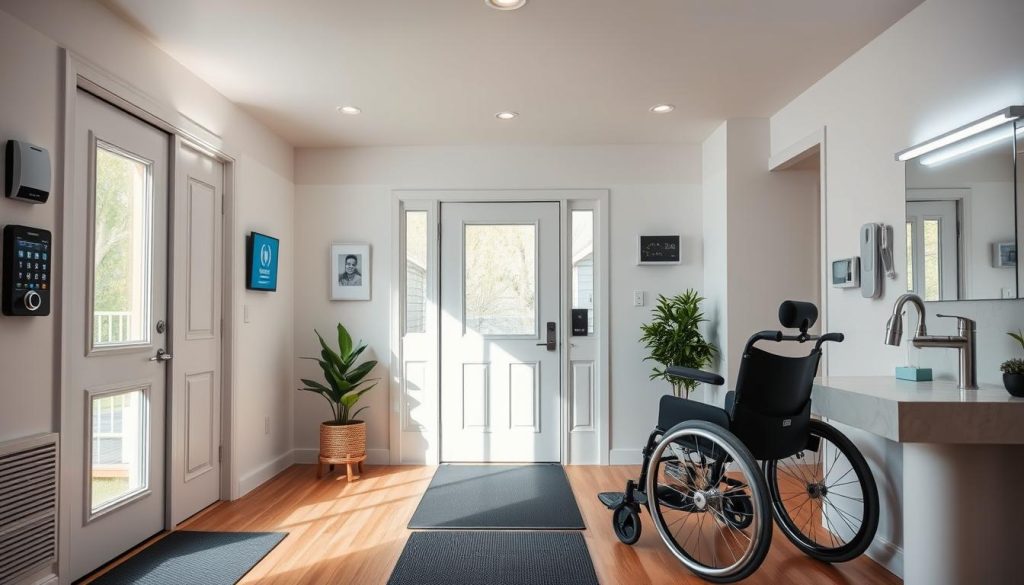
Getting Started with Smart Assistive Devices
To start with smart assistive devices, first figure out what you need. Think about what will help you most in your daily life. With the right gadgets, your smart home can offer more freedom, safety, and ease.
Connectivity and Integration
Creating a smart home for special needs requires good connectivity and integration. A strong internet connection is key. It lets devices talk to each other smoothly. This ensures smart home tech works well for those with special needs.
Choosing the right smart home hub is crucial. It connects all your devices, making control easy. Samsung SmartThings and Apple HomeKit are great options. They work with many devices and are easy to use.
- Compatibility: Make sure the hub works with your devices and supports the right protocols (e.g., Zigbee, Z-Wave, or Bluetooth).
- Scalability: Pick a hub that can handle your devices now and grow with you.
- Security: Go for a hub with strong security, like encryption and two-factor authentication, to keep your system safe.
With a good internet connection and the right hub, you can make a smart home that meets your needs. It makes life better with smart home tech and disability-friendly integration.
Customizing Control Options
Customizing control options in a smart home is key. Accessible devices and inclusive design are crucial. They make the experience better for everyone, especially those with disabilities.
Voice Activation vs. Mobile Apps
Voice activation and mobile apps are top choices for smart home control. Voice activation lets users control devices with voice commands. Mobile apps offer a visual interface. The best choice depends on personal preference and needs.
Remote Controls and Accessibility Features
Remote controls and accessibility features are vital. They include text-to-speech, high contrast modes, and customizable layouts. These features make smart homes more inclusive. Examples of accessible devices include:
- Smart thermostats with voice control
- Smart lighting systems with mobile app control
- Smart security cameras with motion detection
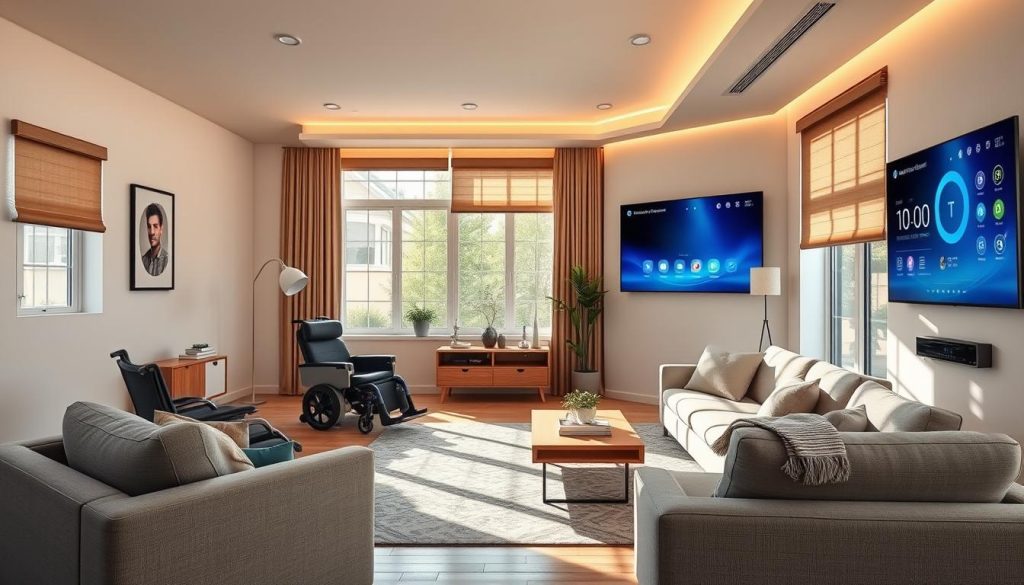
Inclusive design makes homes comfortable for everyone. Customizing control options and using accessible devices helps people with disabilities live more independently. They can enjoy a better life.
| Control Option | Advantages | Disadvantages |
|---|---|---|
| Voice Activation | Hands-free control, easy to use | Dependent on internet connection, may not work with all devices |
| Mobile Apps | Visual interface, customizable | Requires smartphone or tablet, may have steep learning curve |
Enhancing Home Security
Exploring smart homes, I see how vital home security is for people with disabilities. Smart home tech can make homes safer and more secure. I’ll talk about how to boost home security in a smart home.
Smart locks and entry systems are key for home security. They can be controlled from afar, letting in caregivers or emergency services when needed. They also work with other smart devices like doorbells and cameras for more security.
Smart Locks and Entry Systems
- Keyless entry systems for easy access
- Biometric authentication for added security
- Remote monitoring and control of locks and doors
Surveillance cameras and alerts are also important for home security. Cameras can be set up around the house for clear views. Alerts go to phones or tablets for any odd activity. This is great for those with disabilities who might struggle in emergencies.
Surveillance Cameras and Alerts
With these smart home features, people with disabilities can feel safer and more independent at home. Disability-friendly home automation makes homes safe and comfy. With the right tech, everyone can enjoy life fully.
Making Environments Comfortable
Creating a comfortable living space is key for those with special needs. Smart home tech can greatly improve comfort and well-being. It lets people control things like lighting and temperature, making their home cozy.
Smart Lighting Adjustments
Smart lighting can be adjusted with special home tech. People can change light brightness and color with voice commands or apps. This makes their home feel just right.
Automated Window Treatments
Automated window treatments also add comfort. They can be controlled with smart tech, making it easy to open or close curtains. This helps manage natural light and temperature.
Using smart home tech and disability-friendly integration has many benefits. These include:
- Increased comfort and well-being
- Improved control over living space
- Enhanced independence
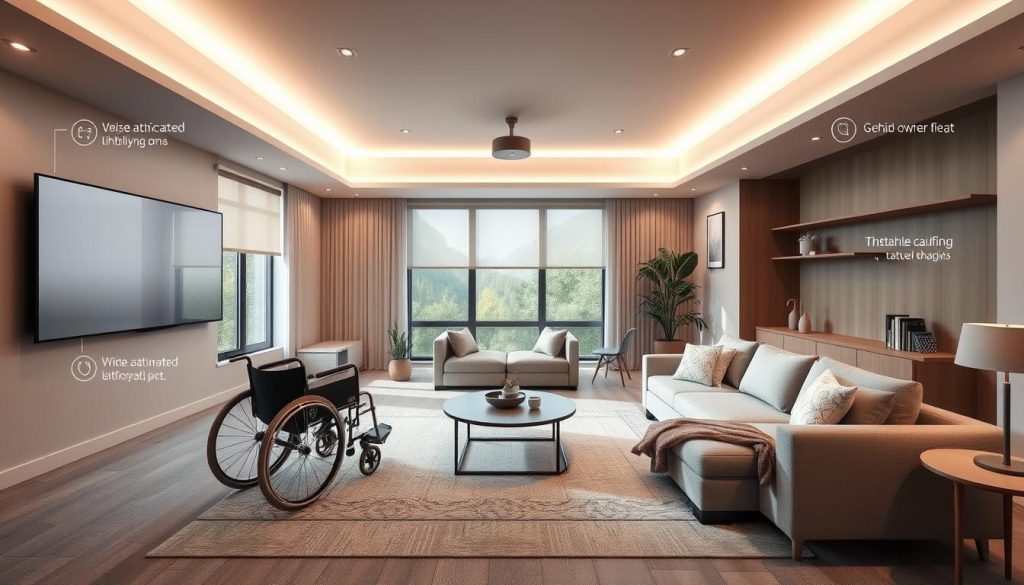
Smart home tech and disability-friendly integration help create a supportive home. It meets the unique needs of individuals, making their living space comfortable and supportive.
Managing Daily Activities
Exploring smart homes shows how important it is to manage daily tasks easily. Assistive technology helps me create a routine that fits my needs. Adaptive home solutions make everyday tasks simpler.
Here are some ways to handle daily activities:
- Smart scheduling and reminder systems to stay on track
- Inventory management with smart tech to keep track of essential items
- Automated lighting and temperature control to create a comfortable environment
Smart Scheduling and Reminder Systems
Smart scheduling and reminders are a big help for people with disabilities. They remind me of medication, appointments, and other tasks. Assistive technology keeps me organized and focused all day.
Inventory Management with Smart Tech
Smart tech for inventory management makes daily tasks easier. Smart sensors in storage areas track what’s in stock. This prevents waste and keeps important items available. Adaptive home solutions make managing inventory more efficient.
Monitoring Health and Wellness
Exploring smart home benefits, I see how vital health monitoring is. Smart sensors help track vital signs and alert for any issues.
Key features of smart health systems include:
- Remote monitoring of vital signs, such as heart rate and blood pressure
- Alerts for falls or other emergencies
- Medication reminders and management
These features are a big help for people with disabilities. They prevent accidents and ensure quick medical help when needed. Smart home adaptations make living spaces safe and supportive for everyone.
For instance, smart sensors track daily activities like sleep, exercise, and diet. This info helps find ways to improve health and gives tailored advice. Using these technologies, people can manage their health better and live a more fulfilling life.
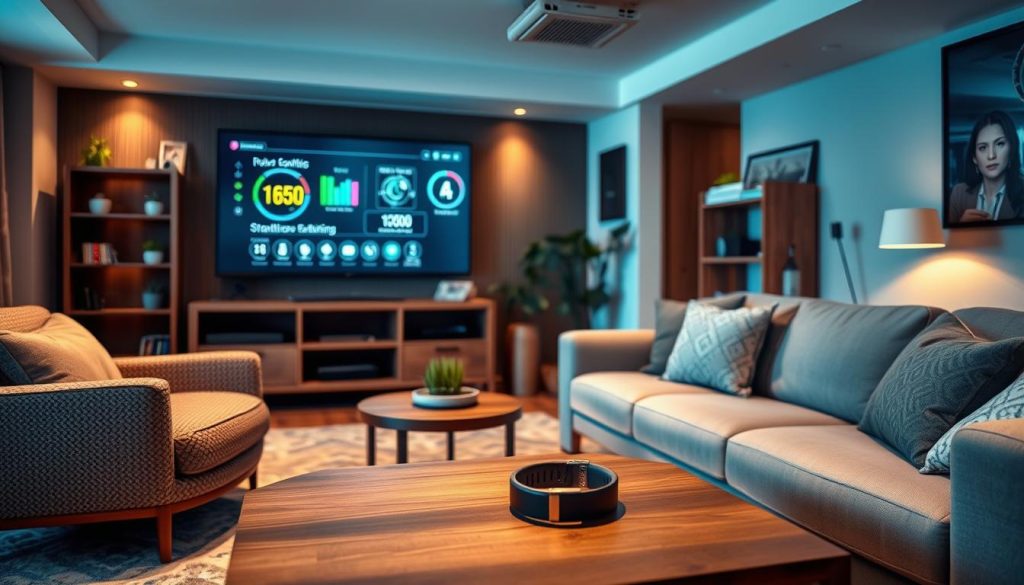
Budgeting for Your Smart Home
Creating a smart home requires careful budgeting. Smart home tech for special needs can be pricey. Yet, it greatly improves life for those with disabilities.
First, figure out what you need and want. Make a list of essential and nice-to-have smart home tech. Then, look up their prices.
Cost Considerations for Various Technologies
Some tech, like smart lights and thermostats, are affordable. But, others like security systems and hubs cost more. Here are some price ranges:
- Smart lighting: $50-$200 per bulb
- Smart thermostats: $100-$300
- Smart security systems: $200-$1,000
- Home automation hubs: $100-$500
Finding Financial Assistance Programs
There are programs to help with smart home costs. Some offer grants for disability-friendly homes. Look into these to find what suits you best.
With smart planning and budgeting, you can make your home comfortable and accessible. Don’t forget to check out financial help options for smart home tech.
| Technology | Estimated Cost | Financial Assistance Available |
|---|---|---|
| Smart Lighting | $50-$200 per bulb | Yes, through some organizations |
| Smart Thermostats | $100-$300 | Yes, through some organizations |
| Smart Security Systems | $200-$1,000 | Yes, through some organizations |
| Home Automation Hubs | $100-$500 | Yes, through some organizations |
Future-Proofing Your Smart Home
Technology keeps getting better, and it’s key to keep your smart home up to date. By staying on top of new smart home trends and planning ahead, your home will stay accessible, comfy, and safe for years. This ensures your living space meets your needs now and in the future.
Staying Updated with Smart Technology Trends
I’ll always be on the lookout for new smart home gadgets and designs. Keeping up with the latest tech helps me find ways to improve my home. This way, I can add features that really suit my lifestyle.
Planning for Future Needs and Upgrades
Tracking tech trends is just part of the job. I also think about how my smart home needs might change. Whether it’s better lighting, more security, or health tracking, I plan for upgrades. This keeps my home inclusive and ready for whatever comes next.

